Cradle-to-Grave Lifecycle Environmental Assessment of Hybrid Electric Vehicles
Abstract
1. Introduction
2. Materials and Methods
2.1. Goal and Scope
2.2. Lifecycle Inventory
2.3. Lifecycle Impact Analysis
3. Results and Discussion
3.1. Fuel Cycle
3.1.1. WTP
3.1.2. PTW
3.1.3. WTW Energy Consumption
3.2. Vehicle Lifecycle
3.2.1. Vehicle Component Manufacturing
3.2.2. Vehicle Fluid Manufacturing
3.2.3. Vehicle Assembly
3.2.4. Transportation to 4S Shops
3.2.5. Maintenance
3.2.6. End-of-Life
3.2.7. Summary of Vehicle Lifecycle
3.3. Cradle-to-Grave Lifecycle
4. Conclusions
- (1)
- The WTW fuel cycle phase is the largest contributor to the overall cradle-to-grave lifecycle energy consumption, accounting for 87% and 77% within the HEV and PHEV models, respectively. This can be attributed to the substantial energy intensity of petroleum extraction and refinement, particularly within the context of a fossil-fuel (primarily coal)-dominated energy mix. Increasing the proportion of renewable energy sources in the energy mix can potentially reduce energy consumption, as well as GHG emissions within the fuel cycle phase. This, in turn, would lead to a corresponding reduction in the overall environmental impact.
- (2)
- Throughout the PTW fuel cycle phase, the PHEV model demonstrates a 14.7% reduction in energy consumption, and a 25% reduction in GHG emissions compared to the HEV model. This is attributed to a higher degree of drivetrain electrification, which reduces reliance on the ICE.
- (3)
- Throughout the vehicle lifecycle phase, the PHEV model exhibits a slight (3.2%) increase in energy consumption, and a corresponding rise (5.6%) in GHG emissions, compared to the HEV model. This disparity can partially be attributed to the higher vehicle mass of the PHEV, while the main contributing factors are associated with the manufacturing and recycling of a larger capacity lithium-ion battery. However, this discrepancy is modest when considering the overall environmental impact observed throughout the entire lifecycle.
- (4)
- Despite having a higher vehicular mass, the PHEV model consumes less energy and emits fewer GHG emissions during vehicle component manufacturing (not counting fluids and batteries). This is due to the reduced usage of energy-intensive materials, such as magnesium, alumnium, rubber, and polymers.
- (5)
- Overall, the PHEV model demonstrates a significant reduction of 29.6% in total lifecycle energy consumption and a 17.5% decrease in GHG emissions compared to the HEV model. This is mostly attributed to the higher degree of drivetrain electrification, resulting in superior fuel economy during the usage phase of the lifecycle. This reduces the demand for gasoline production within the energy-intensive upstream WTP fuel cycle phase of the lifecycle.
- (6)
- Based on the lower overall lifecycle energy consumption and GHG emissions, it can be concluded that the PHEV displays a considerably lower environmental impact than the HEV model.
- (7)
- The cradle-to-grave LCA methodology employed in this study has the capability to evaluate and compare the environmental implications associated with a diverse range of drivetrain electrification options, including conventional internal combustion engine vehicles (ICEVs), battery electric vehicles (BEVs), and fuel cell vehicles (FCVs). Additionally, including diesel- and bio-fuel-powered HEVs and PHEVs allows for meaningful assessments of their environmental impact in comparison to gasoline-powered HEVs/PHEVs. Future LCAs could incorporate material input inventories of both virgin and recycled materials to facilitate a comprehensive assessment of their respective environmental impacts.
Author Contributions
Funding
Institutional Review Board Statement
Informed Consent Statement
Data Availability Statement
Acknowledgments
Conflicts of Interest
References
- Energy Institute. Transport Sector Accounts for Almost 30% of All Energy Consumption Globally. Available online: https://www.energyinst.org/exploring-energy/topic/transport#:~:text=Transport%20sector%20accounts%20for%20almost,in%20our%20society%20and%20economy (accessed on 21 May 2023).
- International Energy Agency. Global EV Outlook 2022; IEA: Paris, France, 2022. [Google Scholar]
- European Environment Agency. Electric Vehicles from Life Cycle and Circular Economy Perspectives; European Environment Agency: Copenhagen, Denmark, 2018. [Google Scholar]
- Samaras, C.; Meisterling, K. Life Cycle Assessment of Greenhouse Gas Emissions from Plug-in Hybrid Vehicles: Implications for Policy. Environ. Sci. Technol. 2008, 42, 3170–3176. [Google Scholar] [CrossRef] [PubMed]
- Wang, D.; Zamel, N.; Jiao, K. Life Cycle Analysis of Internal Combustion Engine, Electric and Fuel Cell Vehicles for China. Energy 2013, 59, 402–412. [Google Scholar] [CrossRef]
- Qiao, Q.; Zhao, F.; Liu, Z.; Jiang, S.; Hao, H. Cradle-to-grate greenhouse gas emissions of battery electric and internal combustion engine vehicles in China. Appl. Energy 2017, 204, 1399–1411. [Google Scholar] [CrossRef]
- Holdway, A.R.; Williams, A.R.; Inderwildi, O.R.; King, D.A. Indirect emissions from electric vehicles: Emissions from electricity generation. Energy Environ. Sci. 2010, 3, 1813–2020. [Google Scholar] [CrossRef]
- Elgowainy, A.; Burnham, A.; Wang, M.; Molburg, J.; Rousseau, A. Well-to-Wheels Energy Use and Greenhouse Gas Emissions Analysis of Plug-in Hybrid Electric Vehicles; Argonne National Laboratories: Lemont, IL, USA, 2009. [Google Scholar]
- Wang, R.; Song, Y.; Xu, H.; Li, Y.; Liu, J. Life Cycle Assessment of Energy Consumption and CO2 Emissions from HEV, PHEV, and BEV for China in the Past, Present and Future. Energies 2022, 15, 6853. [Google Scholar] [CrossRef]
- Gao, L.; Winfield, Z.C. Life Cycle Assessment of Environmental and Economic Impacts of Advanced Vehicles. Energies 2012, 5, 605–620. [Google Scholar] [CrossRef]
- Pipitone, E.; Caltabellotta, S.; Occhipinti, L. A Life Cycle Environmental Impact Comparison between Traditional, Hybrid, and Electric Vehicles in the European Context. Sustainability 2021, 13, 10992. [Google Scholar] [CrossRef]
- Petrauskien, K.; Galinis, A.; Kliaugaite, D.; Dvarioniene, J. Comparative Environmental Life Cycle and Cost Assessment of Electric, Hybrid, and Conventional Vehicles in Lithuania. Sustainability 2021, 13, 957. [Google Scholar] [CrossRef]
- Car Info. Specifications for Toyota Prius XW50. 2023. Available online: https://www.car.info/en-se/toyota/prius/4th-generation-7122916/specs (accessed on 6 May 2023).
- Argonne National Laboratory. Greenhouse Gases, Regulated Emissions, and Energy Use in Transportation Model v1.3.0.13520; Argonne National Laboratory: Lemont, IL, USA, 2019. [Google Scholar]
- Argonne National Laboratory. Summary of Expansions and Updates in GREET 2019. 2019. Available online: https://publications.anl.gov/anlpubs/2019/10/156441.pdf (accessed on 14 May 2023).
- Burnham, A.; Wang, M.; Wu, Y. Development and Applications of GREET 2.7—The Transportation Vehicle-Cycle Model; Argonne National Laboratory: Lemont, IL, USA, 2006. [Google Scholar]
- Ultimate Specs. Toyota Prius XW50 1.8 Hybrid Specs. Available online: https://www.ultimatespecs.com/car-specs/Toyota/111218/Toyota-Prius-(XW50)-18-Hybrid.html (accessed on 5 May 2023).
- United Enviromental Protection Agency. New Fuel Economy and Enviroment Lables for a New Generation of Vehicles. 2011. Available online: https://nepis.epa.gov/Exe/ZyNET.exe/P100BAV0.TXT?ZyActionD=ZyDocument&Client=EPA&Index=2011+Thru+2015&Docs=&Query=&Time=&EndTime=&SearchMethod=1&TocRestrict=n&Toc=&TocEntry=&Qfield=&QfieldYear=&QfieldMonth=&QfieldDay=&IntQFieldOp=0&ExtQFieldOp=0&XmlQuery= (accessed on 10 May 2023).
- Mayyas, A.; Omar, M.; Hayajneh, M.; Mayyas, A.R. Vehicle’s Lightweight Design vs. Electrification from Life Cycle Assessment Perspective. J. Clean. Prod. 2017, 167, 687–701. [Google Scholar] [CrossRef]
- Nemry, F.; Leduc, G.; Munoz, A. Plug-in Hybrid and Battery-Electric Vehicles: State of the Research and Development and Comparative Analysis of Energy and Cost Efficiency; JRC European Comission: Seville, Spain, 2009. [Google Scholar]
- Gaines, L.; Singh, M. Energy and Environmental Impacts of Electric Vehicle Battery Production and Recycling; SAE International: Warrendale, PA, USA, 1995. [Google Scholar]
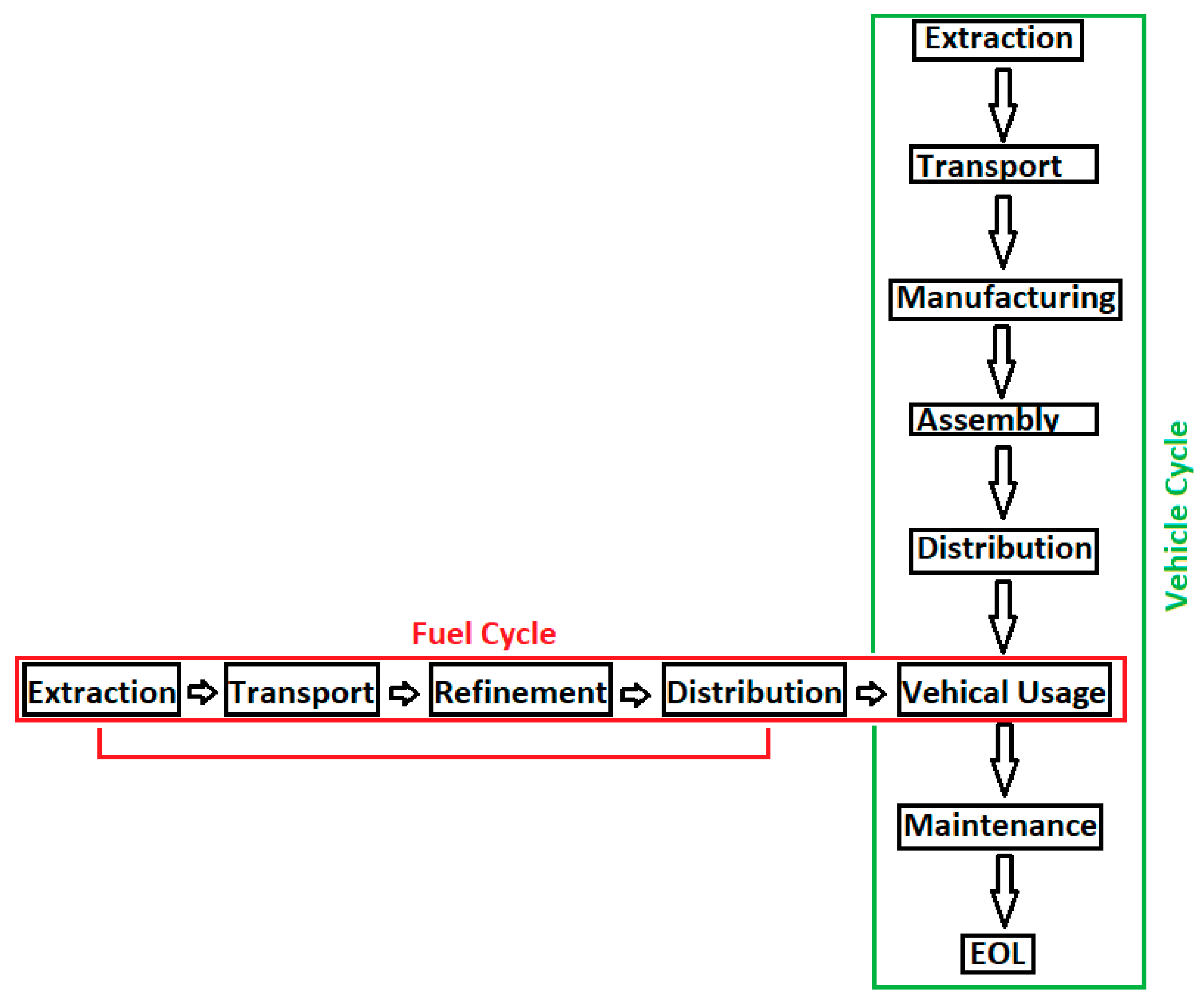
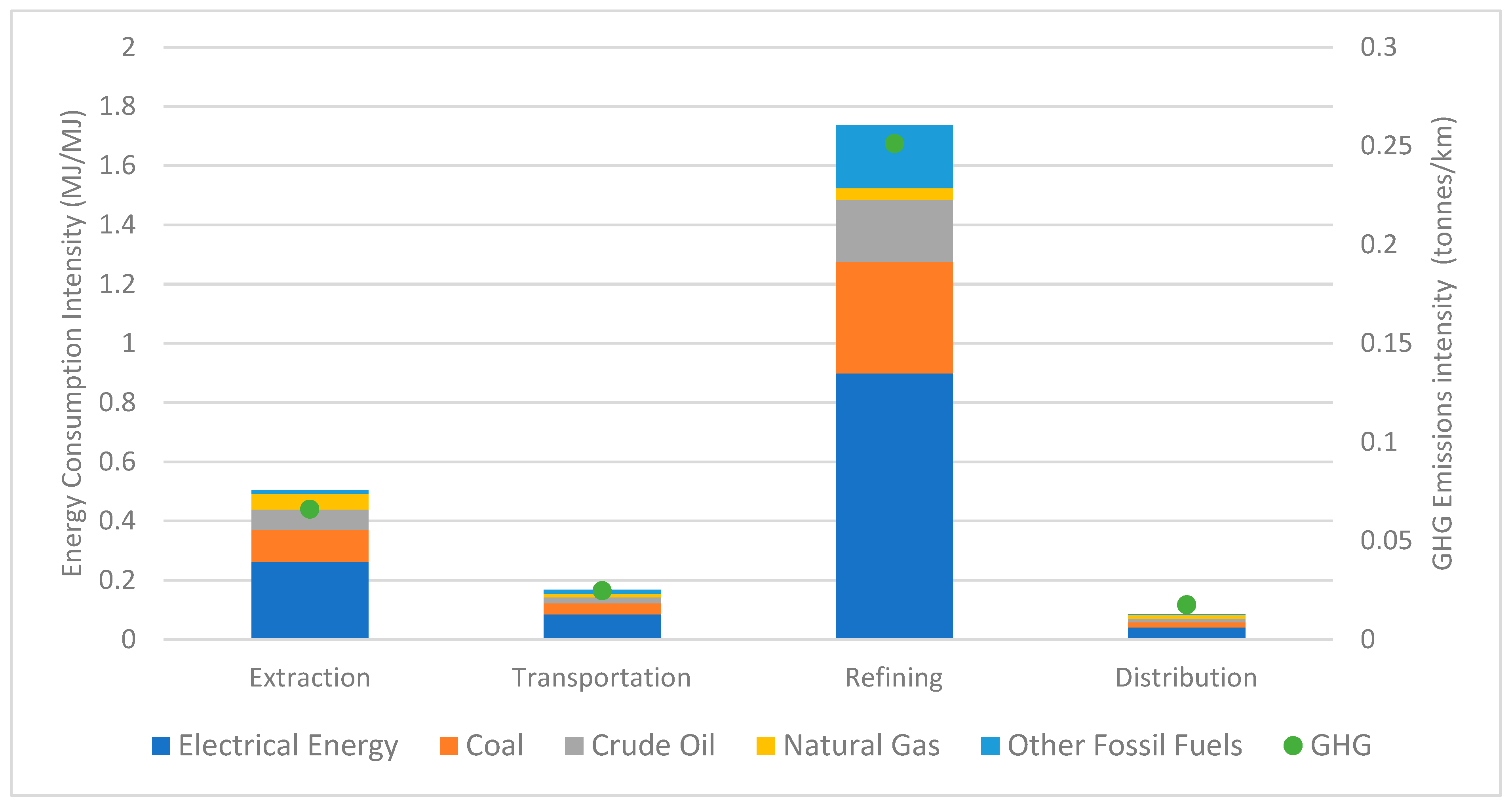


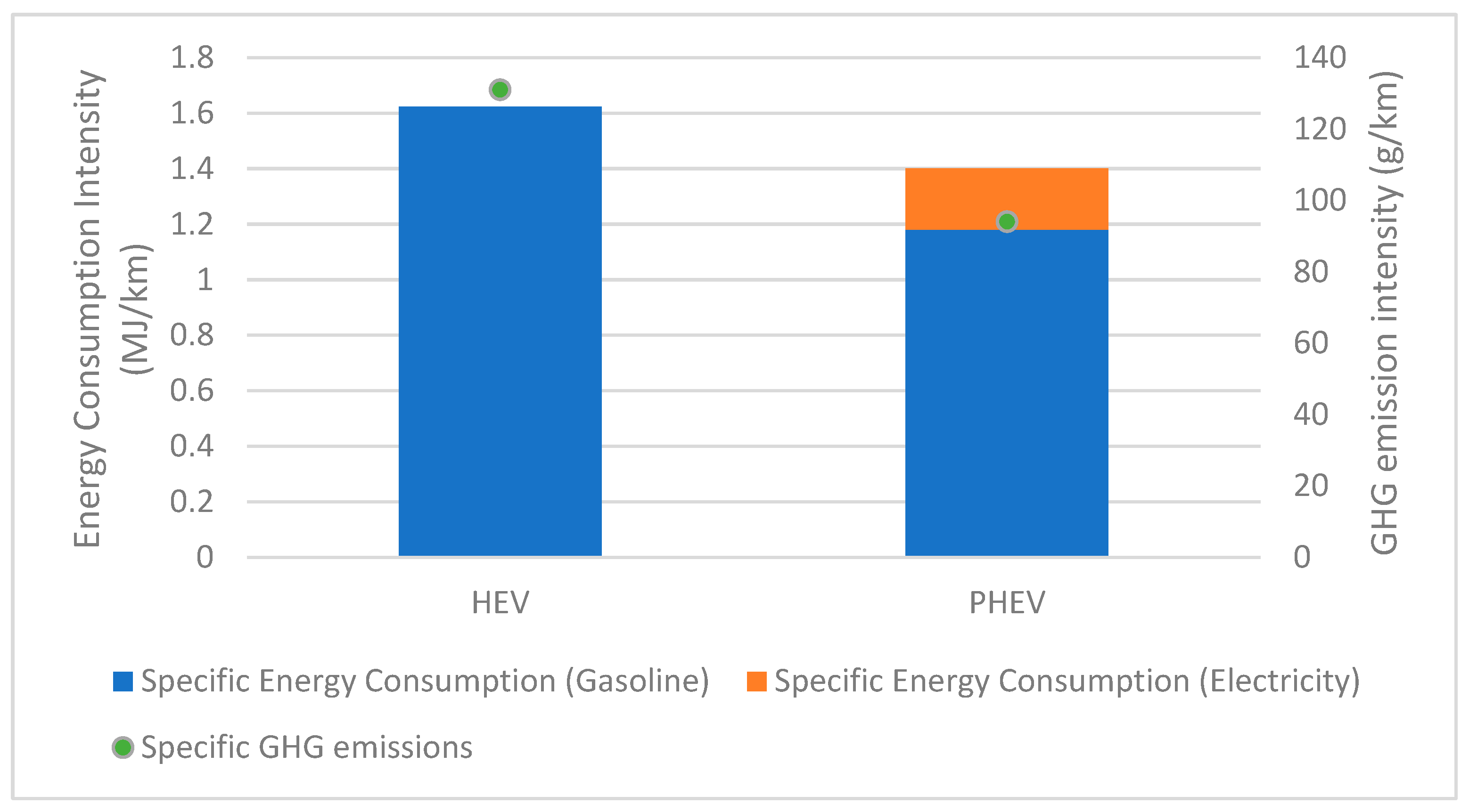
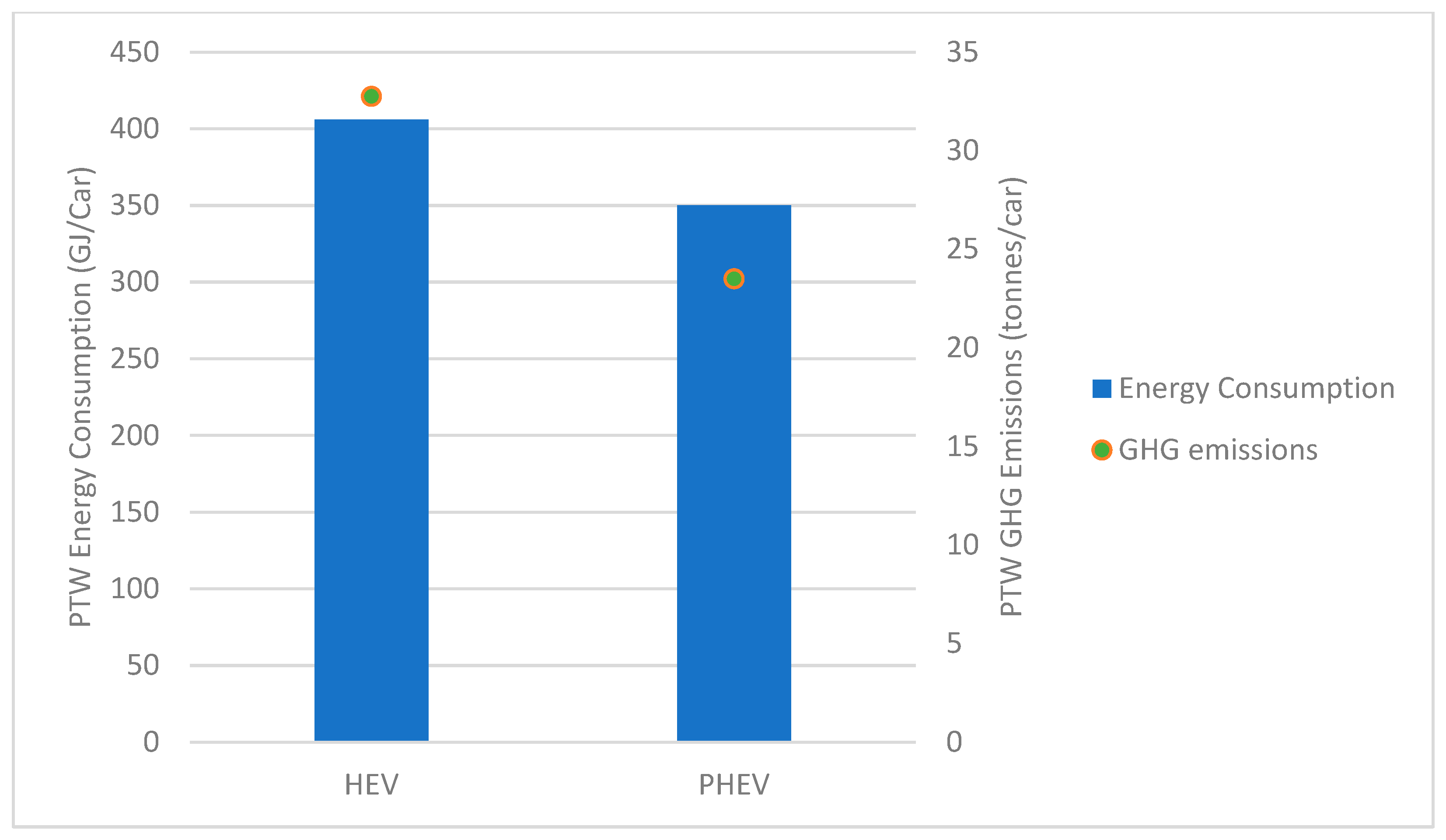
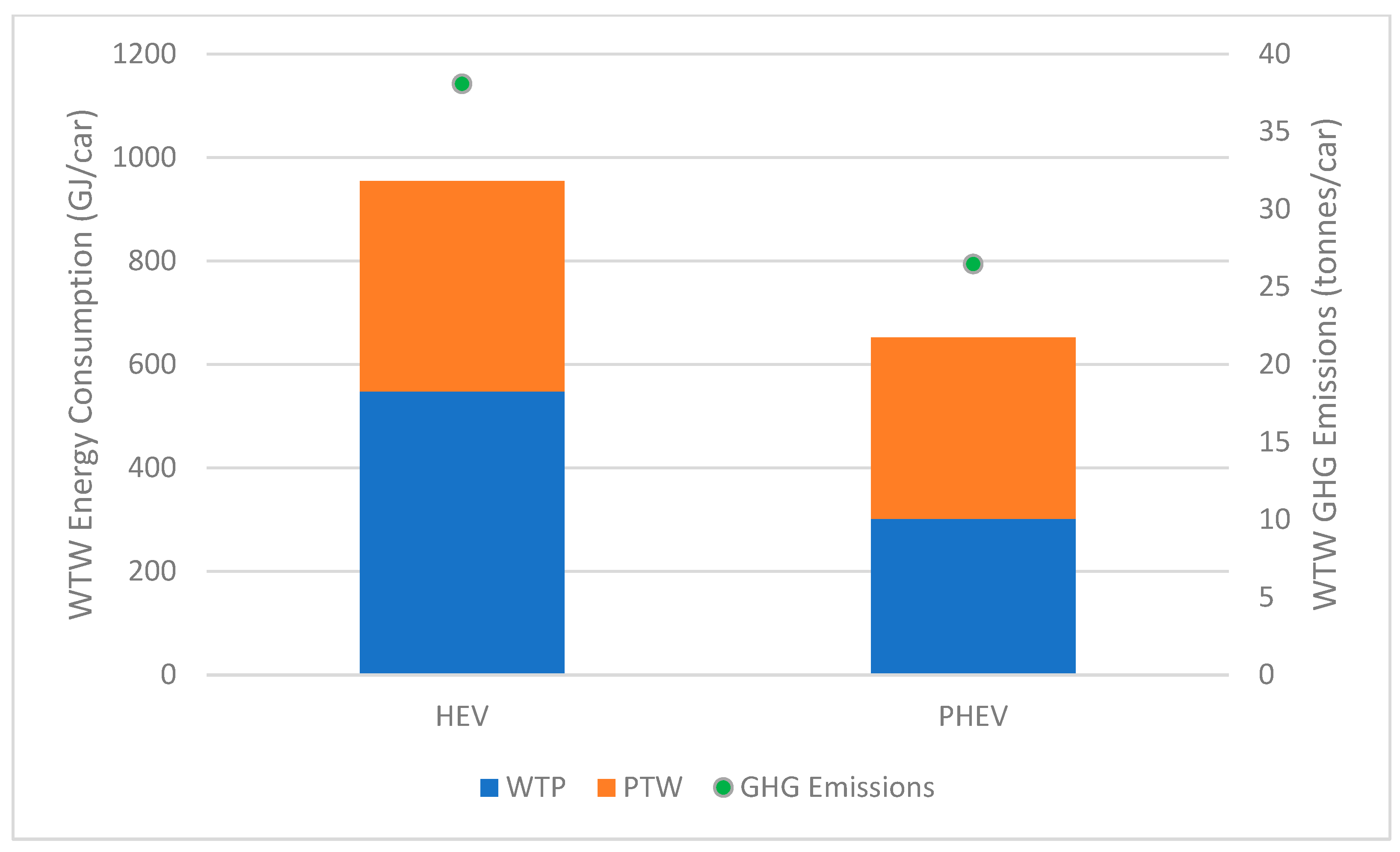




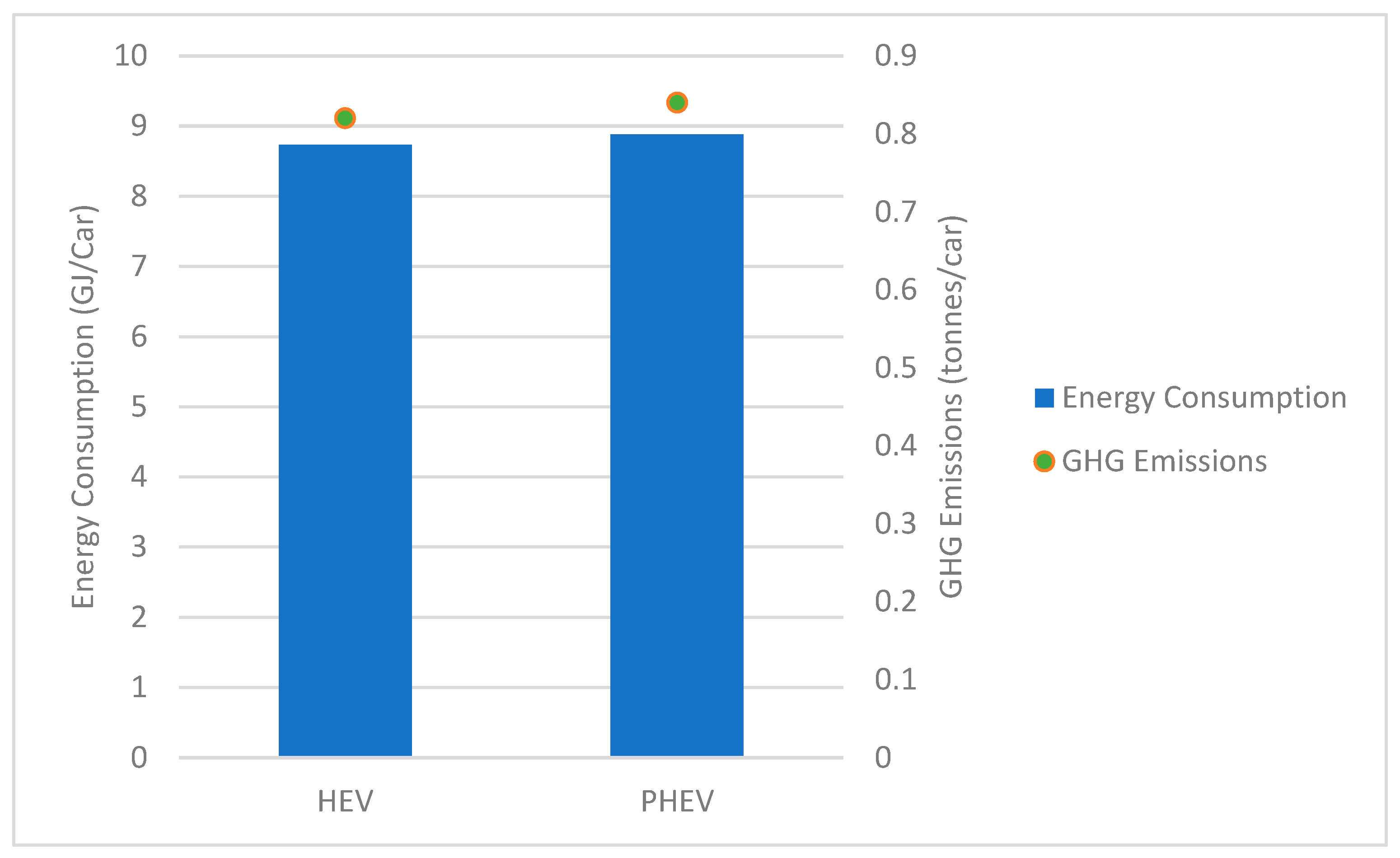
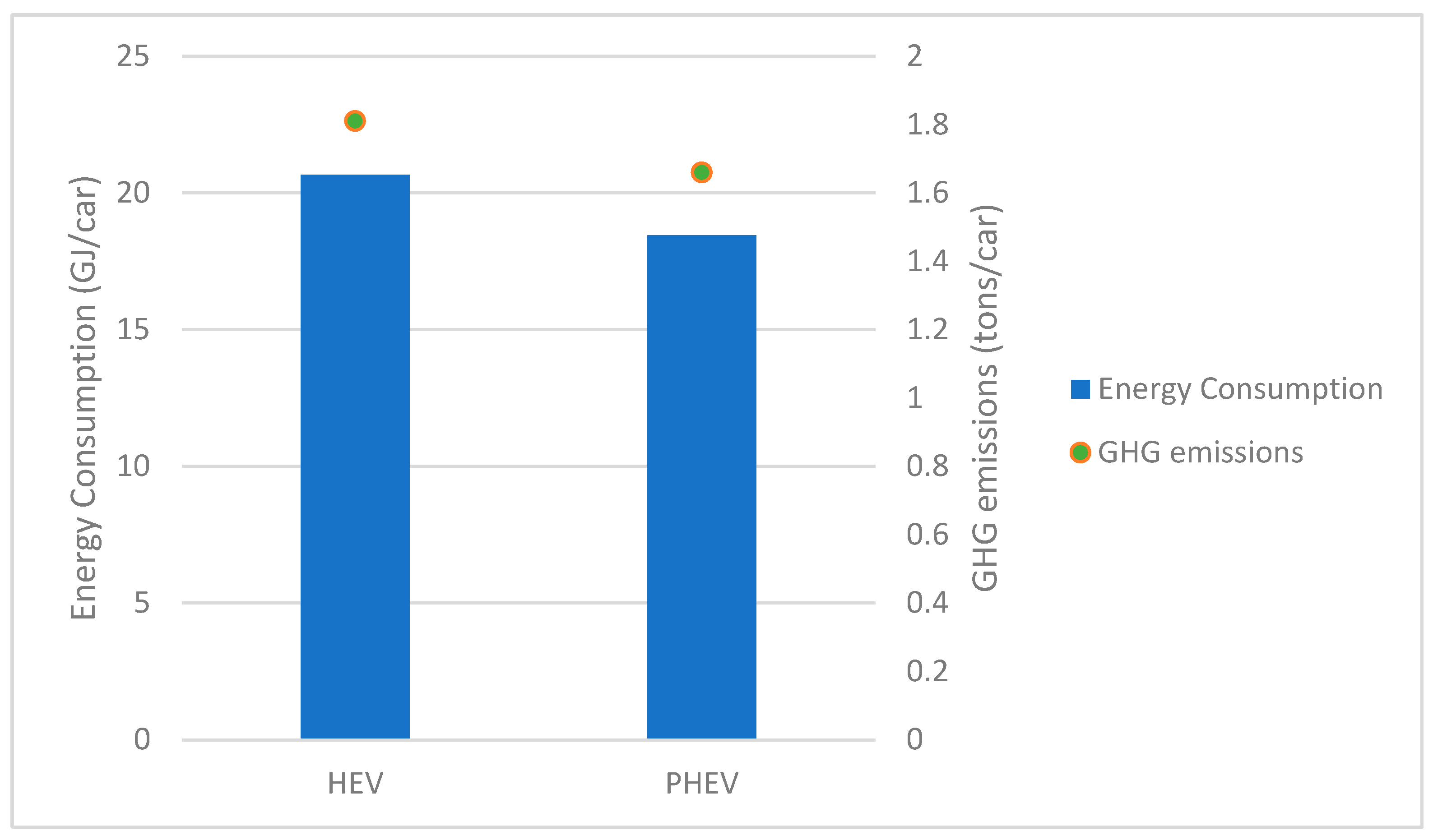



| Publication | Scope of LCA | Subject of LCA | Limitations | Reduction of Environmental Impact through Higher Electrification? |
|---|---|---|---|---|
| Samaras et al. [4] | Cradle-to-gate | ICEV, HEV, PHEV | (1). Lifecycle of Gasoline fuel not included in the LCA scope (2). Transportation, vehicle maintenance, EOL not included in the LCA scope (3). LCA is bound by the conditions of the US | Yes |
| Wang et al. [5] | Cradle-to-grave | ICEV, BEV, five types of FCVs | (1). HEVs and PHEVs not included in the LCA (2). LCA was bound by the conditions of Chin (3). The LCA did not study real-world vehicles | Yes (energy consumption), No (GHG emissions) |
| Qinyu et al. [6] | Cradle-to-gate | ICEV, BEV | (1). HEVs and PHEVs not included in the LCA (2). The LCA did not study real-world vehicles (3). Cradle-to-gate scope did not take into account vehicle usage, maintenance, and EOL. | No |
| Aaron et al. [7] | Well-to-wheel | ICEVs, HEVs, BEVs | (1). LCA scope limited to WTP stage (2). PHEVs not included in the LCA | Yes |
| Elgowainy et al. [8] | Well-to-wheel | ICEV, HEV, PHEV | (1). LCA scope limited to WTP stage (2). PHEVs not included in the LCA (3). The LCA did not study real-world vehicles | Yes |
| Wang et al. [9] | Well-to-wheel | HEV, PHEV, BEV | (1). LCA scope limited to WTP stage (2). LCA was bound by the conditions of China (3). The LCA did not study real-world vehicles | Yes |
| Gao et al. [10] | Cradle-to-grave | HEV, PHEV, BEV, FCV | (1). Lack of comprehensive breakdown of environmental impact calculations within all lifecycle stages | No |
| Pipitone et al. [11] | Cradle-to-grave | ICEV, HEV, BEV | (1). The LCA did not study real-world vehicles (2). The LCA was bound by the conditions of European continent (3). PHEVs not included in the LCA (4). The LCA did not take into account the WTW fuel cycle | No |
| Petrauskiene et al. [12] | Cradle-to-grave | ICEV, HEV, BEV | (1). PHEVs not included in the LCA (2). The LCA is bound by the conditions of Lithuania | No (2015 setting), Yes (2020–2050 setting) |
| Vehicle Parameter | Toyota Prius XW50 HEV | Toyota Prius XW50 PHEV |
|---|---|---|
| Fuel type | Gasoline | Gasoline |
| Powertrain | 2ZR-FXE gasoline engine + dual motor-generator system | 2ZR-FXE gasoline engine + dual motor-generator system |
| Curb Weight (kg) | 1575 | 1605 |
| Power Output (hp) | 123 | 123 |
| Hybrid Fuel-Cell Battery | Lithium Ion | Lithium Ion |
| Mass of Hybrid Fuel-Cell Battery (kg) | 39 | 151 |
| Battery Capacity (kWh) | 1.31 | 4.4 |
| Range Under Full Electric Mode (km) | N/A | 24 |
| Mass Amount in HEV (kg) | Mass Amount in PHEV (kg) | |
|---|---|---|
| Total mass of Vehicle Components (excluding batteries and fluid) | 1378 | 1301 |
| Steel | 899.8 | 865.2 |
| Cast Iron | 77.2 | 67.6 |
| Forged Aluminium | 27.6 | 22.1 |
| Cast Aluminium | 67.5 | 59.9 |
| Copper | 57.9 | 58.5 |
| Glass | 35.8 | 37.7 |
| Plastic | 148.8 | 139.2 |
| Rubber | 23.4 | 22.1 |
| Other (Magnesium + PET) | 40 | 28.6 |
| Lead-Acid Battery | Amount in HEV and PHEV (kg) | Lithium-Ion Battery | Mass Amount in HEV (kg) | Amount in PHEV (kg) |
|---|---|---|---|---|
| Lead | 11.7 | Lithium Iron Phosphate | 10.8 | 50.43 |
| Sulfuric Acid | 1.35 | Graphite | 4.78 | 22.05 |
| Plastic Polypropylene | 1.04 | Adhesive | 0.819 | 3.78 |
| Glass Fibre | 0.357 | Copper | 5.77 | 16.5 |
| Water | 21.3 | Forged Aluminium | 8.93 | 28.8 |
| Other | 1.36 | Lithium Hexafluorophosphate | 0.663 | 2.78 |
| Ethylene carbonate ester | 1.91 | 8 | ||
| Dimethyl carbonate ester | 1.91 | 8 | ||
| Polypropylene | 0.858 | 2.57 | ||
| Polyethylene | 0.156 | 0.453 | ||
| Steel | 0.741 | 2.11 | ||
| Thermal Insulation | 0.117 | 0.453 | ||
| Glycol | 0.507 | 1.51 | ||
| Other | 1.8 | 4.564 | ||
| Fluid Type | Amount in HEV (kg) | Amount in PHEV (kg) |
|---|---|---|
| Lubricant | 4.4 | 3.9 |
| Brake Fluid | 1 | 0.9 |
| Transmission Fluid | 0.9 | 0.8 |
| Coolant | 11.6 | 10.4 |
| Wiper Fluid | 3 | 2.7 |
| Fuel Additive | 15.2 | 13.6 |
| Lifecycle Stage | Energy Consumption Intensity (SEI) | GHG Emissions Intensity (GEI) | ||
|---|---|---|---|---|
| Cradle-to-grave lifecycle | Fuel Cycle | Resource Extraction | Energy equivalent (MJ) required to produce a unit MJ equivalent of gasoline (MJ/MJ) | Mass amount (g) of GHG emitted, to produce a unit MJ equivalent of gasoline (g/MJ) |
| Transportation | ||||
| Refinement | ||||
| Distribution | ||||
| Usage | Energy equivalent (MJ) of gasoline consumed per km travelled during the usage phase of the lifecycle (MJ/km) | Mass amount (g) of GHG emitted per km travelled during the usage phase of the lifecycle (g/km) | ||
| Vehicle Cycle | Vehicle Body Manufacturing | Energy (MJ) required to produce a unit kg of material required for the manufacturing of vehicular components (MJ/kg) | Mass amount (g) of GHG emitted for every kg of produced material required for the manufacturing of vehicular components (g/Kg) | |
| Vehicle Battery Manufacturing | ||||
| Vehicle Fluid Manufacturing | ||||
| Assembly | Energy (MJ) require per unit kg of vehicle assembly (MJ/kg) | Mass amount (g) of GHG emitted per unit kg of vehicle assembly | ||
| Transportation | Energy (MJ) required to move unit kg (MJ/kg) | Mass amount of GHG emitted per unit kg moved (g/kg) | ||
| Maintenance | Energy (MJ) required to replace unit kg of material (MJ/kg) | Mass amount of GHG emitted per kg of material replaced (MJ/kg) | ||
| End-Of-Life | Energy (MJ) required per unit kg of recycled material (MJ/kg) | Mass amount (g) of GHG emitted per unit kg of recycled material (g/kg) |
| Material | Energy Consumption Intensity (MJ/kg) | GHG Emission Intensity (g/kg) |
|---|---|---|
| Steel | 56.82 | 7305 |
| Iron | 17.64 | 1327 |
| Forged Aluminium | 208.08 | 2170 |
| Cast Aluminium | 221.28 | 2301 |
| Copper | 43.48 | 4025 |
| Glass | 21.78 | 2134 |
| Plastic | 114.8 | 7640 |
| Rubber | 43.67 | 4200 |
| Magnesium | 394.51 | 37852 |
| PET | 96.44 | 6219 |
| Body Crushing | Battery Retraction | |
|---|---|---|
| Specific Energy Consumption (MJ/kg) | 1.12 | 84.6 |
| Specific GHG Emissions (g/kg) | 100 | 8212 |
Disclaimer/Publisher’s Note: The statements, opinions and data contained in all publications are solely those of the individual author(s) and contributor(s) and not of MDPI and/or the editor(s). MDPI and/or the editor(s) disclaim responsibility for any injury to people or property resulting from any ideas, methods, instructions or products referred to in the content. |
© 2023 by the authors. Licensee MDPI, Basel, Switzerland. This article is an open access article distributed under the terms and conditions of the Creative Commons Attribution (CC BY) license (https://creativecommons.org/licenses/by/4.0/).
Share and Cite
Rashid, S.; Pagone, E. Cradle-to-Grave Lifecycle Environmental Assessment of Hybrid Electric Vehicles. Sustainability 2023, 15, 11027. https://doi.org/10.3390/su151411027
Rashid S, Pagone E. Cradle-to-Grave Lifecycle Environmental Assessment of Hybrid Electric Vehicles. Sustainability. 2023; 15(14):11027. https://doi.org/10.3390/su151411027
Chicago/Turabian StyleRashid, Shafayat, and Emanuele Pagone. 2023. "Cradle-to-Grave Lifecycle Environmental Assessment of Hybrid Electric Vehicles" Sustainability 15, no. 14: 11027. https://doi.org/10.3390/su151411027
APA StyleRashid, S., & Pagone, E. (2023). Cradle-to-Grave Lifecycle Environmental Assessment of Hybrid Electric Vehicles. Sustainability, 15(14), 11027. https://doi.org/10.3390/su151411027







